#Restigouche
Text
Drag performers and municipal leaders in a small community in northern New Brunswick are dismayed after threats of violence forced the cancellation of a planned performance at the Balmoral Community Centre.
It was a difficult decision, but municipal council felt that it was in everyone's best interest, said Mario Pelletier, mayor of Bois-Joli, a community formed during last year's municipal amalgamations.
Council and the organizing group Restigouche Pride consulted with the RCMP and made the decision jointly after getting threats by phone and online messages, said Pelletier.
Some people threatened acts of violence toward people at the show, while other threats were directed personally at Pelletier and his home. [...]
Continue Reading.
Tagging: @politicsofcanada
#cdnpoli#Restigouche#New Brunswick#reactionary politics#transphobia#queerphobia#homophobia#hate crimes#crime and punishment in canada#public safety
50 notes
·
View notes
Photo
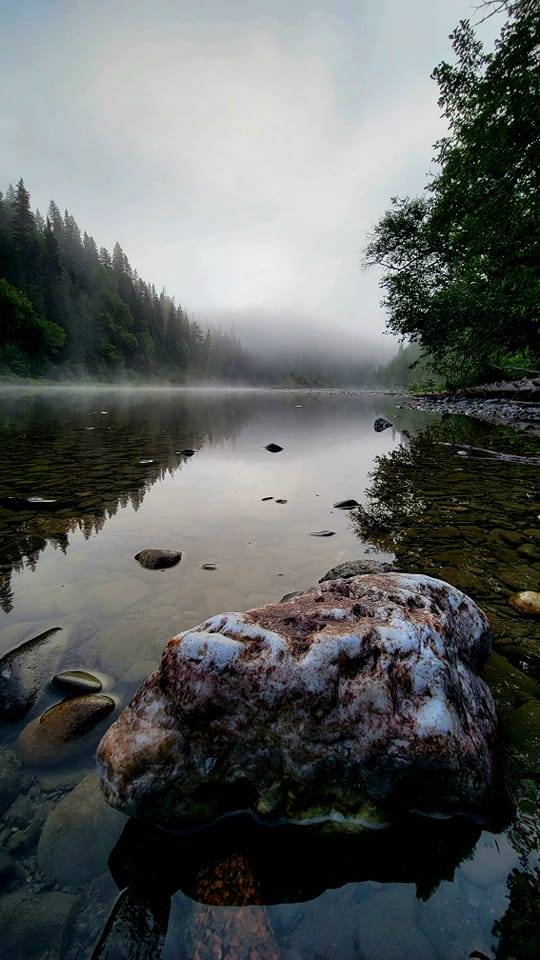
#ameriquedunord#amerique#canada#Nouveau-Brunswick#Riviere Restigouche#kedgwick#brume#brume matinale#Matin#Riviere#eau#rochers#pierres#eau limpide#berge#arbres#foret#Beauté#nature#ciel#Couleurs#vacances#congé#roadtrip
2 notes
·
View notes
Text


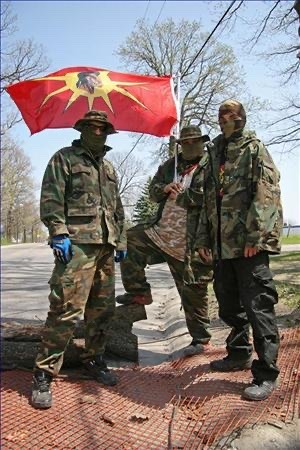
DEFEND THE TERRITORY ZINE PDF
Warrior Publications, Spring 2014
Introduction
Communities that are effective in carrying out resistance will inevitably face some form of state repression, most often carried out by police forces. This text is intended as a review of tactics and techniques that have been used in countering police assaults on crowds and communities.
For police, these types of assaults are referred to as “public order” or “crowd control” operations. Communities targeted by such operations may face riot cops as well as armed tactical units, dog teams, armoured vehicles, the use of chemical agents and baton charges.
Native peoples in Canada have seen the deployment of police crowd control units on numerous occasions since the 1980s. Some notable examples include Listiguj/Restigouche in 1981, Kahnawake 1988, Kanesatake and Kahnawake 1990, Ipperwash 1995, Six Nations 2006, Barriere Lake 2008 and 2012, and most recently in Rexton, New Brunswick, in October 2013.
The most common target for police crowd control operations against Native peoples are blockades. This is because the blockade is highly effective as a form of direct action taken by communities defending their land and people.
While Native peoples in North America have a recent history of armed resistance (including Wounded Knee 1973, Oka 1990, and Ts'Peten 1995), most communities do not typically engage in such actions. Most, however, do have the capability of carrying out blockades and other similar types of low-level direct actions. As corporations and government continue to relentlessly exploit and destroy the natural world, it is highly likely that such actions will increase in frequency in the future as communities act to defend themselves and their land.
265 notes
·
View notes
Photo
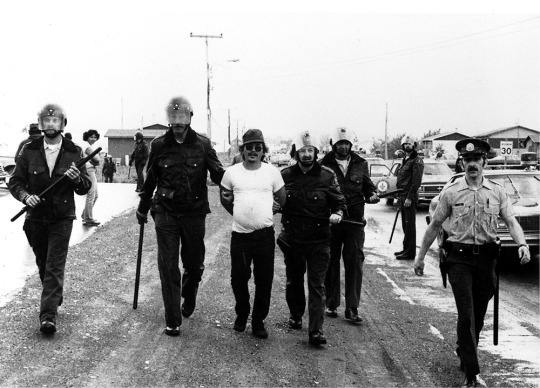
On this day, 11 June 1981, the first of two violent raids by Québec police took place on the Listuguj (Restigouche) reserve of the Miꞌgmaq First Nations people. Officers in full riot gear attacked the reserve, while 35 boatloads of game wardens came ashore to shut down fishing by Mi'gmaq people. During the first raid police seized 100 fishing nets, arrested nine people and was accused of brutally beating others, like fisherman Randy Morrison, who reportedly stated: "I was trying to get out of the way of a group of policemen. A group of them grabbed, handcuffed, and then beat me with their sticks." On June 20, police returned, blockading the area and firing rubber bullets and tear gas. While the government claimed to be acting for conservation reasons, at the same time as shutting down salmon fishing by First Nations people, increasing oil exploration on Indigenous land was continuing apace. At the time there was speculation that the raids were to assert Québec's control of salmon fishing as a precursor to potential independence. Clashes continued in the aftermath of the raids, with two Indigenous people shot by police and another reserve raided by a mob of white Canadians who destroyed a Native salmon net. The second raids were filmed in a landmark documentary by Indigenous director Alanis Obomsawin in her film, Incident at Restigouche. Learn about Indigenous genocide and resistance in the Americas in this book: https://shop.workingclasshistory.com/products/500-years-of-indigenous-resistance-gord-hill https://www.facebook.com/photo.php?fbid=642632851243267&set=a.602588028581083&type=3
157 notes
·
View notes
Text
Let me tell you about John “Foul-Weather Jack” Byron, Captain James Cook, a doctor named James Lind, and also a different doctor named James Lind, and how they all knew each other, helped to cure scurvy, and inadvertently helped to inspire Mary Shelley's novel Frankenstein (1818) and Bram Stoker's Dracula (1897) -- a long-winded history ramble
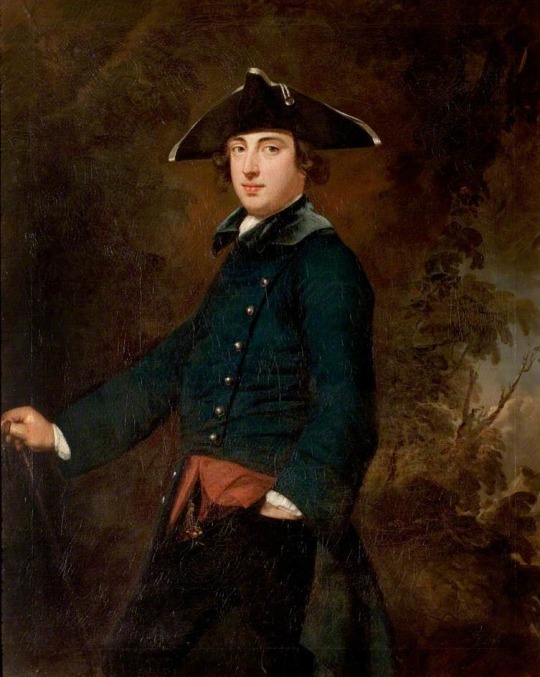

John Byron next to a first edition copy of Frankenstein.
John joined the Royal Navy at 14 and by the ripe old age of 17 had proved himself by surviving a deadly shipwreck off the coast of Chile. The voyage was part of George Anson's famous circumnavigation of the globe done to seize Spanish ships. Only 188 men of the original 1,854 crew members survived; several, including Byron, were taken as prisoners by the Spanish. Recollections of the voyage were sensationalized and it was depicted in stories like William Cowper’s poem The Castaway. John Byron published his own successful memoir, The Narrative of the Honourable John Byron (1768).
The novel's full title deserves attention for it's 18th century pre-Byronic melodrama: "The Narrative of the Honourable John Byron (Commodore in a Late Expedition Around the World) Containing an Account of the Great Distresses suffered by Himself and his Companions on the Coast of Patagonia from the Year 1740, till their Arrival in England, 1746. With a Description of St. Jago de Chili, and the Manners and Customs of the Inhabitants. Also a Relation of the Loss of the Wager Man of War, one of Admiral Anson's Squadron." I can only imagine that had his grandson Lord Byron's memoirs been published instead of burned, their title would have borrowed from his grandfather's by including something similar to "Containing an Account of the Great Distresses suffered by Himself . . ." but I digress.
I do not digress. The beginning of his preface opens with this gem (I've swapped the 18th-century "long s" for a regular one):
"But here I must say, I have been dubious of the partiality of my friends; and, as I think, justly fearful lest the world in general, who may perhaps find compassion and indulgence for a protracted tale of distress, may not give the same allowance to a luxurious imagination triumphing in a change of fortune, and sudden transition from the most dismal to the gayest scenes in the universe, and thereby indulging an egotism equally offensive to the envious and censorious."
Which brings to mind Francis Cohen's criticism of Lord Byron's Don Juan: “Lord B. should have been grave & gay by turns; grave in one page & gay in the next; grave in one line, & gay in the next. And not grave & gay in the same page, or in the same stanza, or in the same line… we are never drenched & scorched at the same instant whilst standing in one spot" (letter to John Murray, 16 July, 1819). And (not the most entertaining part, but to keep things brief) part of Byron's retort: "I will answer [Cohen] who objects to the quick succession of fun and gravity — as if in that case the gravity did not (in intention at least) heighten the fun. His metaphor is that ‘we are never scorched and drenched at the same time!' Blessings on his experience!" (letter to John Murray, 12 August, 1819).
John went on to be considered one of the greatest naval commanders of his era, commanding several ships as captain during the Seven Years’ War and beating the French as leader in the Battle of Restigouche. He later set the record for fastest global circumnavigation at the time while commodore, became a notable explorer, became a commander at multiple Royal Navy stations, and was appointed Governor of Newfoundland in Canada for three years. According to Wikipedia, “his actions nearly caused a war between Great Britain and Spain.”
It seems like he basically just did whatever the hell he wanted. We can see that the apple really doesn't fall too far from the tree. Everyone in the Byron family was kind of crazy. See: psychologist Kay Jamison's Touched By Fire, a novel on the mental illness of famous writers, half of which is focused on Lord Byron (as it should be) and includes an extensive psychological analysis of his whole family tree, which in a short summary brings me back to my previous point: everyone in the Byron family was kind of crazy.
John's health declined after sustaining storm-induced injuries and an unsuccessful attack against the French at the Battle of Grenada. He died at 62 with six living children. His grandson, the poet Lord Byron, borrowed inspiration from John's life and the shipwreck descriptions in his memoir while he was writing the shipwreck sequence in his magnum opus Don Juan.
In an epistle to his half-sister (Epistle to Augusta) Byron mentions their grandfather thus:
"A strange doom is thy father's son's, and past / Recalling, as it lies beyond redress; / Revers'd for him our grandsire's fate of yore— / He had no rest at sea, nor I on shore. / If my inheritance of storms hath been / In other elements, and on the rocks / Of perils, overlook'd or unforeseen, / I have sustain'd my share of worldly shocks, / The fault was mine; nor do I seek to screen / My errors with defensive paradox; / I have been cunning in mine overthrow, / The careful pilot of my proper woe."
On to the Scottish doctor James Lind! He's important because he developed the theory that citrus fruits treated scurvy, and in attempting to prove so he conducted the world's first ever official clinical trial. In his tests, he used the survivors from this famous shipwreck. This likely included Byron himself, being one of the few survivors and having reported the healing effects of citrus in restoring men who were on the verge of death. Needless to say, the discoveries and implications of Lind's clinical trial had an unprecedented impact on the fields of nutrition and medicine, and all of history, particularly in the Caribbean. In 1753 he published his Treatise on Scurvy.
Lind's theories on scurvy influenced the famous Captain James Cook, who implemented these ideas and proved their efficiency by how few men he lost to scurvy compared with every other Captain at the time. When Cook circumnavigated the world on his first voyage, no one died of scurvy. This didn't help with malaria and dysentery, which nearly wiped out his whole crew at one point on a journey to Indonesia. Aside from Anson's shipwreck, Cook's voyages were the other major instance of what I would call "social experiments at sea, or, fuck around and find out: scurvy edition" which led to the development of scurvy research.
As an aside, there is a famous town in Australia named Byron Bay. That town was named by Captain Cook in 1770 as a tribute to John Byron. Cook was sailing around on the HMS Endeavour doing even crazier colonial shit, and he likewise died as the result of his sea travels. He was killed in a scuffle on Hawaiʻi Island which transpired after he had casually tried to kidnap King Kalaniʻōpuʻu-a-Kaiamamao in broad daylight, planning to ransom him out of revenge for the theft of one of his boats, although Cook himself had stolen their sacred wood first after they had been so nice to him. This is what I've gathered from reading a bit about the confusing affair, but the main point is that Cook got what was coming to him. The Journals of Captain Cook were published to major success, contributing to the history of English travel narratives. But Cook is a pretty well-known historical figure so I can't go into his chaotic life any more than this, lest I be writing forever.
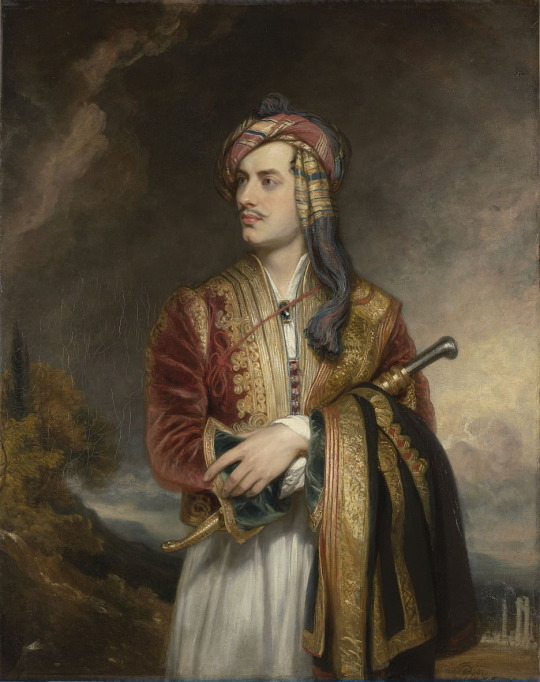

Lord Byron in an Albanian oufit he bought while traveling for 2 years, & Captain Cook thinking about navigation. The backgrounds make them look part of the same painting, no?
Back to the Linds: interestingly enough, the scurvy-studying physician James Lind had a younger cousin who was also a physician named James Lind, as well as a scientist/philosopher/teacher. While teaching at Eton, this Lind became a tutor and mentor of a young Percy Bysshe Shelley, and had such an impact on him that Shelley refers to Lind in several of his works. Shelley especially enjoyed Lind’s experiments regarding galvanism - the study of bringing things to life with electricity. It is widely believed by scholars that Shelley’s conversations and rememberances about Lind at Lord Byron's Villa Diodati were some of the primary inspiration for Mary Shelley’s novel Frankenstein (1818).
For further reading on Shelley's Lind: The real Doctor Frankenstein? by Christopher Goulding via Journal of the Royal Society of Medicine. Lind's Wikipedia page has a section devoted to Frankenstein.
Percy Shelley described his Lind:
". . . exactly what an old man ought to be. Free, calm-spirited, full of benevolence, and even of youthful ardor: his eye seemed to burn with supernatural spirit beneath his brow, shaded by his venerable white locks, he was tall, vigorous, and healthy in his body; tempered, as it had ever been, by his amiable mind. I owe to that man far, ah! far more than I owe to my father: he loved me, and I shall never forget our long talks, where he breathed the spirit of the kindest tolerance and the purest wisdom . . ."
A tie-in to vampire literature: Lind is also thought to be an influence on Bram Stoker’s Dracula (1897), which was influenced by (Lord Byron’s doctor) John Polidori’s novel The Vampyre, the first ever vampire novel, which was inspired by Lord Byron’s short vampire story Augustus Darvell, which was written at the same time as Frankenstein during their infamous ghost story competition at Villa Diodati. Augustus Darvell was inspired by Byron's travels through Eastern Europe, and was likely in part inspired by (another famous Romantic poet) Samuel Taylor Coleridge’s gothic poem Christabel, which Byron terrified Percy Shelley with after reading it aloud at the Villa Diodati, and which Byron loved so much that he helped Coleridge publish it through his own publisher. Christabel began in 1797 but wasn't published until 1816 for this reason.
To continue on vampires: Byron's enemy, the famous poet Robert Southey (who Byron roasted in Don Juan, among other works, and basically cancelled him as a result) also wrote a poem called Thalaba the Destroyer (1801) which is sometimes considered to be the first true depiction of a vampire in English literature. He also wrote it while traveling. Shelley (and Keats) both loved this poem, and so it also *could have* inspired some of the conversation at the Villa Diodati if Shelley had related the vampire theme to Christabel or Darvell. Southey is also the first English writer to write on Haitian zombi folklore, which would later become the zombie of modern horror. Southey was also reportedly in love with Mary Wollstonecraft Godwin, the mother of Mary Shelley and philosopher who wrote A Vindication of the Rights of Woman (1792), one of the most influential proto-feminist texts.
I relate these connections to demonstrate how small the literary world was at the time; so small that all the writers pretty much knew each other. In 1801, the English population was about 11 million, and in 1899 had grown to around 37 million due to industrialization (source: Black, Joseph, et al. "British Literature: A Historical Overview." The Broadview Anthology of British Literature, Broadview Press, vol. B, 2010, p. 70).
That's nearly the current population of London alone, but around 75% of that 11 million English population in 1801 was rural, whereas at the end of the century the national population was about 75% urban (source: same as prior), again due to industrialization. London in the early 19c was much less populated than today, and the amount of people who were educated or even merely literate was also much smaller than today. So really, it makes sense that all of the artists/writers/scientists/aristocrats knew each other. But it's still insane to see examples of how small the world really is and always has been.

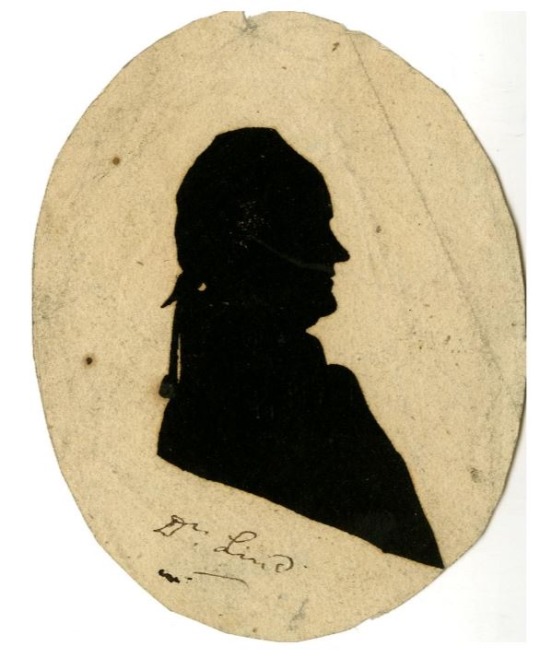
The front-facing portrait is of Scurvy Lind, the shadow portrait is of Galvanism Lind.
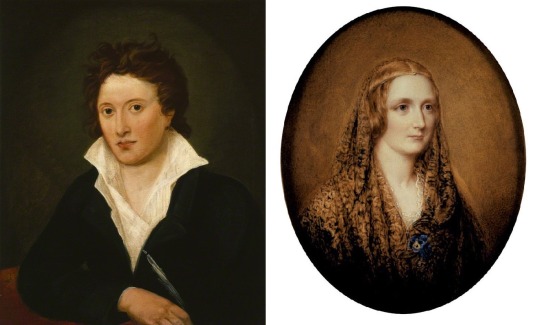
The Shelleys: the King and Queen of Romanticism.

Southey, Coleridge, Polidori, Stoker: some early Kings of Vampirism (as represented in popular British literature).
#james lind#scurvy trials#scurvy#lord byron#mary shelley#percy shelley#literature#english literature#science#history#rambles#john byron#english history#england#english#uk#1800s#19th century#frankenstein#british history#romanticism#writing#my analysis#my writing#my essays#ramble
71 notes
·
View notes
Text



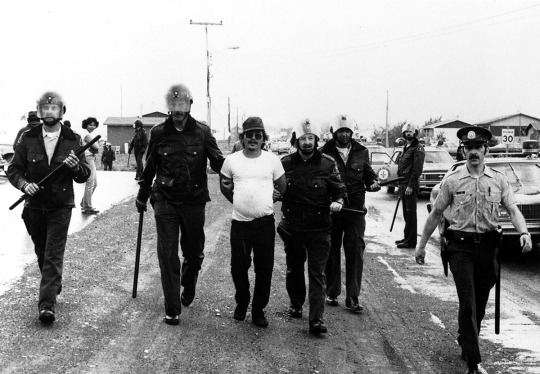
At Ninety-One, Alanis Obomsawin Is Not Ready to Put Down Her Camera
She revolutionized cinema and is inspiring the next generation of Indigenous filmmakers
Until a few years ago, the National Film Board was headquartered in a sprawling suburban complex off a Montreal highway. In 2019, it moved into its new downtown space, a slick thirteen-storey building designed with Obomsawin in mind. In a reception room on the main floor, a recording of an interview with her plays on loop. On the second floor is the 138-seat Alanis Obomsawin Theatre. A few floors above, a still from Kanehsatake: 270 Years of Resistance covers the wall of a conference room. If her work and image are part of the building’s DNA, it’s because she has become, as Wente puts it, the raison d’être of Canada’s public film producer and distributor. “If you were to ask me why the NFB should exist,” Wente tells me, “she’s why. She’s who I would point to.”
Read more at thewalrus.ca.
Stills and photography from When All the Leaves Are Gone (2010), Kanehsatake: 270 Years of Resistance (1993), Christmas at Moose Factory (1971), and Incident at Restigouche (1984), courtesy of the National Film Board
#Film#Documentary#Indigenous#Alanis Obomsawin#Directed by women#Photography#September/October 2023#Zoe Heaps Tennant
56 notes
·
View notes
Text
sa tagal kong nag aantay ng documents sa employer ko, ngayon ko lang na email yung multicultural association ng restigouche para sa mga pre-arrival services, sin, health card insurance, at housing search. oh diba? nahihirapan kasi ako maghanap ng bahay e ako lang naman mag isa ang pupunta tapos naalala ko na parang may sinend syang link para dito. kaya dinouble check ko. ayon, nag send ako sa email nila. hahaha.
so yon. in Jesus' name, maayos lahat lahat para tuloy tuloy ang blessings.
ciao.
3 notes
·
View notes
Photo

The race is on. From onboard the 'Ocean Limited' bound for Halifax, across the Restigouche River valley we see the section bound for Gaspe, otherwise known as the 'Chaleur', that had uncoupled from our train at Matapedia and is now operating as a separate train for the remainder of its trip to the Gaspe Peninsula.
07/04/2013
#ocean#chaleur#via rail#2013#montreal#halifax#gaspe#trains#passenger train#history#matapedia#quebec#dome car
6 notes
·
View notes
Text
La première québécoise de ᑕᐅᑐᒃᑕᕗᒃ Tautuktavuk (Sous nos yeux) un film primé de Lucy Tulugarjuk et Carol Kunnuk – le lundi 11 décembre 2023 à 19h

Isuma Productions, Isuma Distribution International et Kingulliit Productions,en collaboration avec Cinema Politica, ont le plaisir d’annoncer que le long métrage dramatique primé TAUTUKTAVUK (SOUS NOS YEUX), coréalisé par Lucy Tulugarjuk (Tia and Piujuq, One Day in the Life of Noah Piugattuk, Atanarjuat : The Fast Runner) et Carol Kunnuk (Welcome to my Qammaq, Being Prepared, Attagatuluk), sera présenté en première québécoise comme film de clôture de la saison d’automne de Cinema Politica Concordia le lundi 11 décembre 2023 à 19h à l’Université Concordia (salle H-110).
La première québécoise sera suivie d’une séance de questions et réponses et d’une conversation avec Lucy Tulugarjuk et la documentariste Alanis Obomsawin (Incident at Restigouche, Kanehsatake : 270 Years of Resistance, Our People Will Be Healed). La table ronde sera animée par l’artiste multidisciplinaire, cinéaste et conservateur d’art Asinnajaq (Upinnaqusittik, Three Thousand). Tous les détails sont disponibles ici.
TAUTUKTAVUK (SOUS NOS YEUX) a été présenté en première mondiale au Festival international du film de Toronto (TIFF) en septembre 2023, où il a remporté le prix Amplify Voices BIPOC & Canadian First Feature Award, ainsi que le Sun Jury Award au 2023 ImagineNATIVE Film Festival.
Après sa première québécoise au Cinema Politica, TAUTUKTAVUK (SOUS NOS YEUX) sortira en salle à Montréal le 12 janvier 2024, avec des projections du film sous-titré en français et en anglais au Cinéma Moderne.Ce film inuit contemplatif, à la fois provocateur et subtilement intersectionnel, explore les points de convergence entre les mesures pandémiques, la violence domestique, la famille et les traumatismes intergénérationnels. Brouillant la frontière entre fiction et non-fiction, après un événement traumatisant, Uyarak et sa sœur aînée Saqpinak entreprennent un difficile voyage de guérison qui leur rappelle l’importance de la communauté, de la culture et de la famille. TAUTUKTAVUK (SOUS NOS YEUX) explore les questions de violence domestique et de toxicomanie du point de vue de deux femmes inuites.
0 notes
Text
A $17-million class-action settlement has been approved after plaintiffs alleged decades of mistreatment of psychiatric patients at the Restigouche Hospital Centre in northern New Brunswick.
In a decision released today, the chief justice of the Court of King's Bench approved the deal between former patients and the province and Vitalite Health Network, saying it was "fair and reasonable."
Justice Tracey DeWare referred to the agreement as the largest negotiated class-action settlement ever approved in New Brunswick.
Continue Reading.
Tagging: @politicsofcanada
36 notes
·
View notes
Text
Indigenous Resistance Through Film
Obomsawin reimages Indigeneity through the medium of filmmaking. Following the lives of Indigenous people across “Canada,” and taking a particular interest in their struggle for sovereignty and state recognition, Obomsawin renegotiates the objective, omnipotent presence of the documentary filmmaker and rather positions herself within the struggle, centering Indigenous culture, history, and experiences as the argument, evidence, and conclusion of her films. Therefore, her work contests twofold; firstly the ways in which documentary filmmaking as a medium has been used in the colonial sense to control public perception/understanding of a certain event, people, or history, and secondly, the subject matter of her films — seminal Indigenous issues and events in Canada — expose the continuous colonial violence that is enacted upon by all levels of government towards Indigenous people, whilst challenging official histories and narratives about Canada’s relationship with Indigenous people. Her films continue to see what the rest of the county cannot see, or chooses to ignore.
Obomsawin’s filmmaking practice begins with listening. Often, before any second that is caught on camera, she will go into the community that she is working with alone, without a crew or a camera, and engage in conversation and daily life. She insists on building relationships and connections first, attentive to witnessing before any act of producing. Her participatory style of filmmaking adapts the didactic documentary tradition. Obomsawin appears in all of her films, seated in homes interviewing subjects, engaging with children in schools, or barricaded behind the lines during a resistance. You will often hear her voice encouraging subjects during interviews, or laughing with a group. Her presence throughout the films reminds viewers of her intimate, intrinsic connection to the subject matter — as an Indigenous woman she is just as much shaped and informed by the events, communities, and histories that she documents.
The subject matter of Obomsawin’s films speak to the ongoing effects of settler colonialism, genocide, persecution, and state surveillance of Indigenous people. Incident at Restigouche (1984) follows the raids on the Listuguj Mi'gmaq First Nation by the Quebec provincial police, as an effort of imposing restrictions on their fishing rights, Richard Cardinal: Cry from a Diary of a Métis Child (1986) is a devastating examination of Canada's child welfare system in regards to the (mis)treatment of Indigenous children and youth, and the harm that the system causes. Christmas at Moose Factory (1971), her first feature-length film, is filmed at a residential school in northern Ontario around Christmas time, Hi-Ho Mistahey! (2013) follows the campaign Shannen’s Dream, which lobbies for improved educational opportunities for Indigenous youth, and examines the on-going impacts of the lack of proper education for Indigenous youth, and Our People Will Be Healed (2017) profiles the Helen Betty Osborne Ininiw Education Resource Centre in Norway House Cree Nation, the structure of the school, offering a vision for what Indigenous based education could look like in the future, whilst recognizing the challenges the school is facing today.
Kanehsatake: 270 Years of Resistance (1993) documents the Kanehsatà:ke Resistance/Oka Crisis and is the most well known of Obomsawin’s films. Had it not been for Obomsawin and her crew documenting 250 hours worth of footage behind the barricade, in standoff with the military, and at the end of resistance, the public memory of this event would have been shaped solely by one-sided government press releases, limited CBC reporting, and Prime Minister Mulroney asserting that the Mohawk warriors were dangerous criminals with illegal weapons. Emotive, intense moments behind the barricade, articulated through interviews with individual Mohawk warriors, offer a closer account of the events instead. Obomsawin’s uncompromising and partisan view of what occurred at the Oka golf course gave way for Mohawk historical narratives to be re-articulated and Indigenous efforts for self-determination to be legitimised.
1 note
·
View note
Text
Royal Canadian Navy Rcn Hmcs Terra Nova (dde 259) Restigouche-class Destroyer Hawaiian Shirt Man
The Royal Canadian Navy's Terra Nova was built in Japan in 1959. She was first deployed to the Korean War as a destroyer and then served in the Vietnam War. She was finally decommissioned in 1974 and restored to her original purpose as a Destroyer. She has been used as a ship and Landing Force training ship for the Canadian Armed Forces and is currently in the Reserve Force.
Get it here : Royal Canadian Navy Rcn Hmcs Terra Nova (dde 259) Restigouche-class Destroyer Hawaiian Shirt Man
Home Page : tshirtslowprice.com

0 notes
Text
0 notes
Photo

HMCS Restigouche, returning home to Montreal in 1945.
#HMCS Restigouche#Destroyer#C Class#RCN#formerly the HMS Comet#Montreal#1940s#1945#Jacques Cartier Bridge
18 notes
·
View notes



